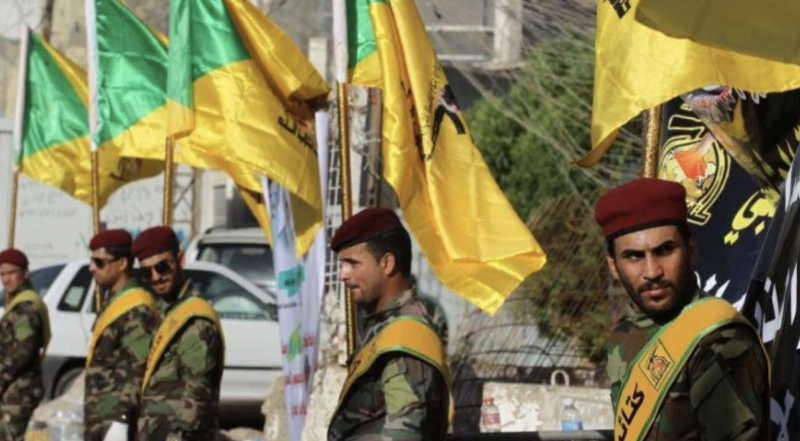
Fighters from the Kataib Hezbollah, pro-Iranian brigades forming part of the Hashd al-Shaabi in Iraq. (Credit: Ahmad al-Rubaye/AFP via Getty Images)
This is a 180 degree shift. Kataib Hezbollah expressed Tuesday evening its desire to cease its attacks against the “occupying forces,” i.e. the US, “in order to avoid embarrassing the Iraqi government.”
Washington said earlier that the strike that killed three of its soldiers — at the Tower 22 base in Jordan on Sunday morning— and wounded dozens, has the “footprint” of the Iran-aligned armed group, which is the leading member of Iraq’s Popular Mobilization Forces.
Shortly before the group’s statement, Joe Biden said that he would respond to the attack. US Secretary of State Antony Blinken had already warned the day before that the response would be “multileveled, come in stages and be sustained over time.” What does the armed group’s unexpected decision mean?
Iranian pressure, Iraqi mediation?
Some see this as a sign pointing to the Iranian pressure on Kataib Hezbollah, while the Islamic Republic, which denied any involvement in the attack in Jordan, could fear a retaliatory strike on its territory or interests in the region.
Since the weekend, many Republican hawks have been urging Biden to take direct action against Tehran, which for its part warned that it would respond swiftly to any attack on its territory, interests or nationals.
The group’s statement, which seems to support the hypothesis that it is a decision desired by the Iranian regime, explicitly distanced Iran from its actions.
“Our brothers in the [resistance] axis, and particularly the Islamic Republic, do not know how we practice jihad and they often oppose the pressure and escalation against the US occupying forces,” said the group.
Commenting on the group’s statement, Hamidreza Azizi, a researcher with the Stiftung für Wissenschaft und Politik, wrote on X: “It clearly indicates a pressure from Iran.”
Kataib Hezbollah have also stressed that they would continue to defend themselves if a hostile US act were to target them. This would place their actions within the framework of the implicit rules of engagement between the US and “Axis of Resistance.”
According to the Iraqis, this decision was the result of intense efforts by Prime Minister Mohammed Shia al-Sudani,who was elected in 2022 thanks to the Iran-aligned Shiite Coordination Framework.
Speaking to Reuters, his foreign affairs adviser, Farhad Alaaldin, said that Sudani “has been hard at work in the past few days, engaging with all relevant parties inside and outside Iraq.” He urged parties to “support the efforts of the Prime Minister to prevent any possible escalation.”
Just before Sunday’s strike, the Iraqi government had begun talks with the US to assess its presence in the country, where it still has around 2,500 troops as part of the international coalition against the Islamic State organization, with a view to preparing a possible withdrawal.
This is an objective of the country’s Iran-aligned groups that increased pressure on the prime minister, after a US strike in Baghdad in early January killed two commanders of the Harakat al-Nujaba militia, which is part of the Popular Mobilization Forces.
The Middle East Eye quoted a former US official as saying that Washington could try to target a senior member of Lebanese Hezbollah, Mohammad Hussein al-Kawtharani, who has been coordinating efforts to get US troops out of Iraq.
Autonomy of the ‘Axis of Resistance’
While the “plausible denial” of Iran’s responsibility for the actions of its regional proxies also applies to Sunday’s strike, many analysts believe that the Iran-aligned groups in the region have become more autonomous and independent in recent years.
Some even suggested that groups that the Iranian authorities have supported for decades are now beginning to take strategic decisions that are different from, or even contrary to, Tehran’s interests.
Referring to the pre-Oct. 7 strike of balance between Iran and its US enemy, consisting of well-defined red lines and rules of engagement, Arash Azizi, a lecturer at Clemson University, wrote in The Atlantic on Tuesday, “the forces of the so-called Axis of Resistance threaten this ... balance for the regime in Tehran, which can no longer fully control them.”
This situation is even clearer when it comes to Iraq, where the plurality and diversity of the Iran-aligned militias make effective control more difficult. According to the lecturer, they “are among the most firmly rooted in Iran’s Shiite Islamist ideology,” which paradoxically makes them more difficult “to be convinced by the strategic calculations of the Iranian establishment’s more pragmatic sections.”
Finally, the historian concluded that “by tying Iran’s fate to an unruly Axis, Khamenei has endangered his country and put it at serious risk of war,” which is something he has sought to avoid until now.
This article was originally published in L'Orient-Le Jour. Translated by Joelle El Khoury.